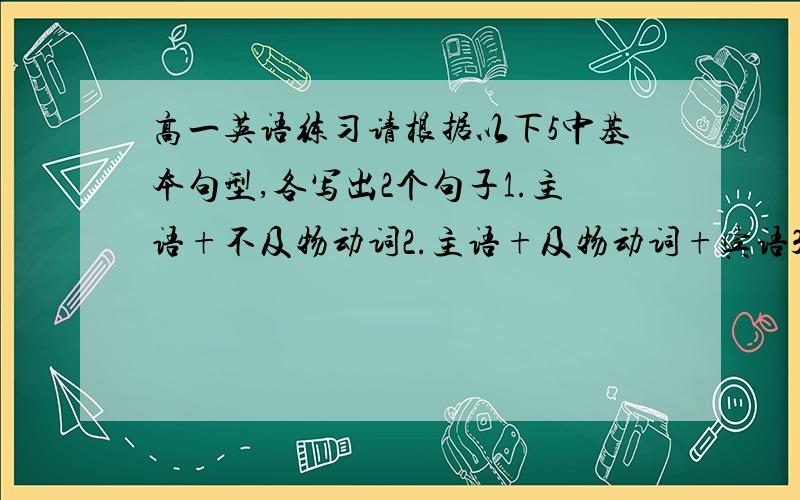高一英语练习请根据以下5中基本句型,各写出2个句子1.主语+不及物动词2.主语+及物动词+宾语3.主语+系动词+宾语4.主语+及物动词+间接宾语+直接宾语5.主语+及物动词+宾语+宾语补足语
来源:学生作业帮助网 编辑:作业帮 时间:2024/11/27 14:01:37

高一英语练习请根据以下5中基本句型,各写出2个句子1.主语+不及物动词2.主语+及物动词+宾语3.主语+系动词+宾语4.主语+及物动词+间接宾语+直接宾语5.主语+及物动词+宾语+宾语补足语
高一英语练习
请根据以下5中基本句型,各写出2个句子
1.主语+不及物动词
2.主语+及物动词+宾语
3.主语+系动词+宾语
4.主语+及物动词+间接宾语+直接宾语
5.主语+及物动词+宾语+宾语补足语
高一英语练习请根据以下5中基本句型,各写出2个句子1.主语+不及物动词2.主语+及物动词+宾语3.主语+系动词+宾语4.主语+及物动词+间接宾语+直接宾语5.主语+及物动词+宾语+宾语补足语
英语基本句型有五个:S+V, S+V+Cs, S+V+O, S+V+Oi+Od, S+V+Od+Co, 其共有特征是主谓结构(S+V).
句子成分主要有四种:主语S、谓语动词V、补语(主语补语Cs,宾语补语Co)和宾语(直接宾语Od,间接宾语Oi).
●Pattern 1 (S + V)
1. 此句型中,“V” 是不及物动词,后面无宾语,如:
My right arm hurts.
但通常有后续成分或称状语(A),即 S+V+A,如:
She lived happily.
The sun rises every morning.
2. 在有些句子中,主语或谓语或某一部分可省略,如:
(I) Hope to see you again soon.(省略主语)
Who called? Jane (did).(省略谓语)
●Pattern 2 (S + V + Cs)
1. 此句型的 “V” 是连系动词,“Cs” 是主语补语,或称表语.充当主语补语的有名词、代词、形容词、副词、数词、介词短语、动词 V-ing 形式或 V-ed 形式、不定式及名词性从句等,如:
My first name is Bill.
Life is colorful.
Seeing is believing.
Our belief is that things will improve.
2. 常见的连系动词有下列几类:
a. 表示“判断”:be;
b. 表示“变得”、“成为”:become, come, go, fall, get, grow, prove, turn 等;
c. 表示“保持着某一状态”:hold, keep, lie, remain, rest, sit, stay 等;
d. 表示“看起来”、“好像”:appear, look, seem 等;
e. 表示“实感”:feel, sound, taste, smell 等.
e.g. She is a teacher and I am a doctor.
Spring comes and all trees turn green.
He stayed awake all night.
You don’t look happy, what's the matter?
Their plan sounds wonderful.
●Pattern 3 (S + V + O)
1. “V” 是及物动词,后面需跟一个宾语,可充当宾语的有名词、代词、数词、不定式、V-ing 结构及名词性从句等,如:
I understand the program.
She asked to see the manager.
Mary is considering changing her job.
He said that he would call me tomorrow.
2. 这种结构有时必须跟状语,意义才完整(即 S + V + O + A),如:
We accepted their advice in buying a new car.
She completed the assignment just as the bell was ringing.
We don’t trust him because he often lies.
You make a promise only when you know you can keep it.
●Pattern 4 (S + V + Oi + Od)
1. 此句型的 “V” 称为双宾及物动词,其后需跟间接宾语 “Oi”(通常指人)和直接宾语 “Od”(通常指物或事).
2. 此类动词大都具有给与的意义,常见的有allow, assign, award, bring, buy, cause, choose, fetch, find, get, give, grant, hand, leave, lend, offer, owe, pass, pay, post, promise, read, recommend, refuse, render, return, sell, send, show, sing, take, telephone, touch, tell, throw, wish, write 等,如:
I gave him the book.
I’ll return you the dictionary soon.
3. 有时间接宾语可移至直接宾语之后,但要加相应的介词如 “to”,“for”,“of” 等,试比较:
Betty gave her daughter an apple.
→Betty gave an apple to her daughter.
Father bought him a bike.
→Father bought a bike for him.
He asked me a question.
→He asked a question of me.
●Pattern 5 (S + V + Od + Co)
该句型中,谓语动词虽有宾语,但句子意义仍不完整,需加补语 “Co” 补足其意义.充当宾语补语的有名词、形容词、副词、介词短语、不定式短语及分词等,如:
We call him a fool.
We found the house empty.
Our neighbors built their wall high.
We believe you to be an honest man.
I heard them singing in the classroom.
常用的这类动词有:
appoint, believe, call, catch, choose, consider, declare, elect, fancy, feel, find, hear, imagine, judge, keep, know, leave, make, name, need, prefer, prove, see, select, suppose, think, vote 等.
Noun Clause(名词从句)
名词从句包括主语、宾语、表语和同位语等从句.它们可以由下列连词引导:从属连词 that, whether, if;连接代词 who(ever), whom, whose, what(ever), which(ever);连接副词 when, where, why, how, how much / many /long /often 等.
●主语从句在句中作主语
That mathematics finds its use in every science is evident.
Whoever is tired may rest.
Why the earth moves round the sun is quite clear now.
主语从句常放在句尾而用 it 作形式主语使句子更加平衡,这时口语中常省略 that, 如上面第一句改成“It is evident (that) mathematics finds its use in every science.”更好.
在下列情况下必须把主语从句放在句尾而用 it 作形式主语:
1. 主句谓语是被动语态时,如:
It is said that he is a good doctor.
2. 主句是疑问句或感叹句时,如:
Is it true that the film star will come?
How wonderful it is that we'll visit the Great Wall tomorrow.
3. 主句谓语动词是 appear, turn out, happen, occur, come, strike, follow, matter 等时,如:
It happened that she had a cold and didn't go with us that day.
It turned out that I was wrong.
4. 表示说话人的推测或评价,如在 it seems, it may be, it is (un)likely, it is (im)possible, it is a pity, it is a wonder 等结构中,如:
It seems that this test is reliable.
It is a pity (that) she can't go with us.
5. 强调主句的表语时,如:
It is a mystery to me how it all happened.
It is necessary that he should do so.
●宾语从句在句中作宾语
I thought (that) you had read the book.
We should learn to tell whether an element is poisonous or not.
Do you know who invented this?
1. 宾语从句后有宾语补足语时常移至句末,而用 it 做形式宾语放在前面,如:
The experiment makes it clear that air has pressure.
2 宾语从句可作某些介词和某些作表语用的形容词的宾语,如:
The resistance of a wire also depends upon what material it is made of.
We are sure (that) it will be a success.
3. 宾语从句可以是直接引语也可以是间接引语,如:
He asked me, “Are you from Chengdu?”(直接引语)
He asked me whether I was from Chengdu.(间接引语)
●表语从句在句中作表语
The reason is (that) we haven't raised enough money.
That is what we want to know.
●同位语从句在句中作补充说明名词及其短语的从句
I am in doubt whether I should buy or not.
He expressed his hope that he would visit China again.
Relative Clause(定语从句)
引导定语从句的关系词有
1. 关系代词 who, whom(代人);which(代物);that, whose, as (代人或物).它们的数和人称要和先行词一致,格取决于它们在句中充当的成分,如:
A machine is a kind of device which (that) helps to do work.
Those who want tickets should go to the office.
The technician whom we met yesterday had worked out a new automatic device.
先行词前有限定词 all, any, every, (a)few, no, only, some, very 或序数词或形容词最高级等修饰时,或先行词是指物的不定代词 all, little, few,much, none 或 -thing 构成的复合不定代词时,一般只用关系代词 that,如:
Any boy that wants to succeed must work hard.
There is not much that can be done.
I've made up my mind, and nothing (that) you say will change it.
先行词是指示代词 such 或 same 时,只用 as, 先行词被指示形容词 such 或 same 修饰时,通常用as,如:
This book is not such as I expected.
She said the same as she said before.
I've never seen such dogs as you describe.
I'll wear the same dress as I did last time.
2. 关系副词有:when, where, why, 它们都在从句中作状语,其先行词总是表示时间、地点或理由的名词,如:
The days when they had to import grain from abroad have now passed.
Air moves from places where the pressure is higher to places where the pressure is lower.
He refused to tell the reason why he did it.